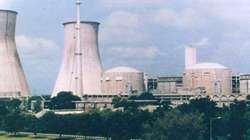N power: Rise in developing nations, decline in developed ones
According to S&P, concerns about the safety of nuclear plants and nuclear waste storage solutions, an aging global nuclear fleet, and massively escalating costs for many new projects have added to the industry's woes.

The nuclear power sector will see growth in the developing economies like Russia, China and India over next two decades, while several developed economies are planning to phase out their plants and opting for renewables that are competitive, said the global credit rating agency Standard and Poor's (S&P).
In its latest research report 'The Energy Transition: Nuclear Dead or Alive - S&P' said the global nuclear industry, accounting for 10 per cent of global power generation, faces many challenges as governmental and regulatory policies have shifted toward renewables, especially after the 2011 Fukushima nuclear accident.
According to S&P, concerns about the safety of nuclear plants and nuclear waste storage solutions, an aging global nuclear fleet, and massively escalating costs for many new projects have added to the industry's woes.
"We see little economic rationale for new nuclear builds in the US or Western Europe, owing to massive cost escalation and renewable cost-competitiveness, which should lead to a material decline in nuclear generation in those countries by 2040," said S&P Global Ratings credit analyst Elena Anankina.
"Several developed countries, including Germany, Belgium, Switzerland, and Spain, are planning to phase out nuclear plants. Others, such as South Korea, Sweden, and even France aim to reduce it. In the US, the continuity of nuclear plants and future life extensions are under threat from prevailing low power prices," the report said.
However, the continued growth of nuclear power in some development markets like Russia, China and India signals there will be marginal increase in the generation of atomic power in the world over the next two decades.
The credit rating agency said Russia and China have established nuclear expertise, a largely state-owned vertically integrated nuclear chain, and funding from the government or from state-related banks.
Even in India a similar situation persists.
Answering a question in the Parliament, Union Minister Jitendra Singh on June 26 said, the present installed nuclear power generation capacity in the country is 6,780 MW.
He said the total nuclear power capacity in India would reach 13,480 MW by the year 2024-25 with the completion of projects under construction, including 500 MW Prototype Fast Breeder Reactor (PFBR), being implemented by Bharatiya Nabhikiya Vidyut Nigam Ltd. (BHAVINI).
The Government has also accorded administrative approval and financial sanction for 12 nuclear power reactors aggregating a total capacity of 9,000 MW, which are scheduled to be completed progressively by the year 2031.
On their completion, the total nuclear power capacity would reach 22,480 MW. More reactors based on both indigenous technologies and with foreign cooperation may be planned in the future, he said.
According to the S&P, in developed markets, renewables are significantly cheaper and offer quicker payback on scalable investments at a time when power demand is stagnating.
New nuclear construction requires massive upfront investments in complex projects with long lead times and risk of major cost overruns. Returns over nuclear assets' long useful life are exposed to fundamental uncertainties about the global energy transition, technology development, regulatory shifts, and increasingly volatile electricity markets.
"Still, we believe that a combination of steady growth in renewables and maintenance of a material share of nuclear baseload over the next decades will help to achieve huge CO2 savings and smooth the energy transition, as it will remove the need for new gas units and give time for renewables to fill the void," S&P said.
On the small modular reactors, the rating agency said though it requires lower initial capex, they are expensive as compared to renewables and less scalable and do not address fundamental nuclear safety and nuclear waste issues.
As compared to Western Europe and North America, governments in many developing markets view nuclear generation as a way to reduce carbon emissions while meeting soaring primary energy demand (for example in China and India), addressing security of supply (such as in Ukraine), and offsetting natural constraints on renewable expansion (Eastern Europe).
Nuclear generation in emerging markets remains economically attractive, and often considerably cheaper than in developed markets.
According to S&P, life extension programme for nuclear power plants will be attractive as a transitionary measure over the next two decades in Europe and the US as countries would find it more difficult to cope with the supply gap if both coal fired and nuclear generation baseload were rapidly phased out at the same time.
Nuclear plant life extensions may also prevent construction of new gas units, giving time for renewables to fill the void.
In addition, a too fast nuclear phaseout would pose other challenges, including the huge impact on CO2 emissions, security of electricity supply, and grid stability while adding to decommissioning costs, S&P said.
ALSO READ | Impeachment proceedings a 'sham and should not be allowed': Trump
ALSO READ | Kashmiris trained in Pakistan to fight Indian army, admits Musharraf